Rega RP8 Review
Rega RP8
Unusual design, stunning sound
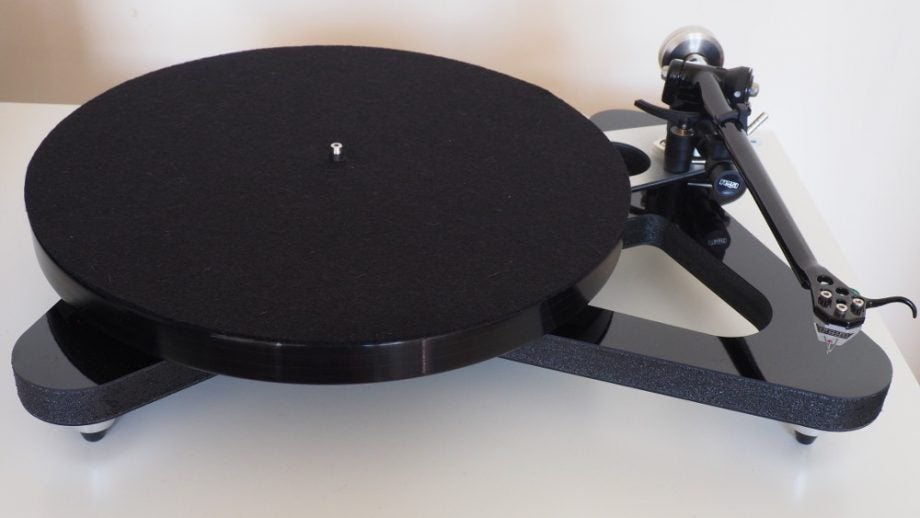
Verdict
Pros
- Stunning treble and mid-range clarity
- Great timing and attack
- Tight, controlled bass
Cons
- Not the most immersive soundstage
- Skeleton plinth looks unfinished
Key Specifications
- Review Price: £1598.00
- Belt-driven
- Rega RB808 9-inch tonearm
- TT-PSU external power supply
- 33/45rpm
- Dust cover
What is the Rega RP8?
This high-end turntable doesn’t mark a change in Rega’s design philosophy, but does make some concession to the idea that expensive kit shouldn’t just sound different; it should look different too.
The RP8’s plinth is constructed from a high-tech sandwich that sticks with Rega founder Roy Gandy’s aim for ultimate rigidity with minimal mass, but it’s been chopped into two parts. The inner skeleton is the only part that matters, while use of the outer frame is optional – it’s really only there to provide a base for the dust cover and some protection for the plinth’s core. Your choice: space-age or traditional.
The Rega RP8 comes with the RB808 tonearm as standard, but having a cartridge fitted will cost extra. I tested it with Rega’s Apheta 2 moving-coil cartridge, which is available factory-fitted and brings the price of the package up to £2,298.
Related: Best turntables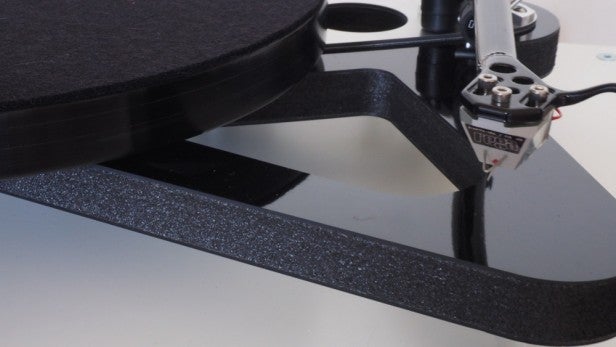
Rega RP8 – Design and Features
First let’s talk about that plinth. It’s super-lightweight but extremely stiff, thanks to phenolic skin sandwiching a nitrogen-expanded polyolefin foam core. At first glance it looks like a standard Rega rectangle, but then you notice that someone seems to have taken a jigsaw to the central area, cutting it out in a sort of X shape.
The plinth is, in fact, two pieces that are totally decoupled from one another. The inner part houses the bearing, motor and tonearm mount, and has three screw-adjustable feet. It’s been heavily braced on the top and bottom, in the same fashion as the Rega Planar 3, albeit with a magnesium upper brace.
If you choose to use the outer plinth, the inner part simply sits within it, but doesn’t actually make contact – Rega promises that using it doesn’t affect the sound at all. It has its own circular feet that surround the inner plinth’s pointier feet, and at its rear you’ll find Rega’s standard fittings for the supplied dust cover.
Related: Sony PS-HX500 Hi-Res Audio turntable review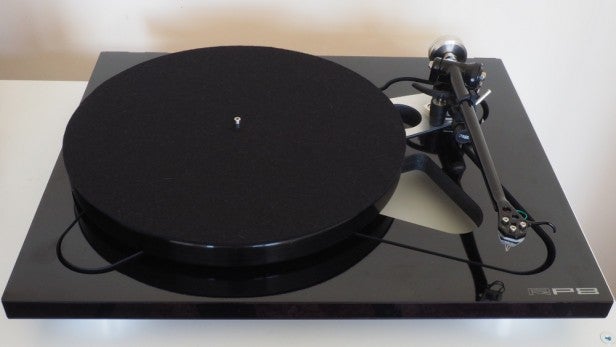
Basically there are three reasons why you might fancy using the outer plinth: for the dust cover, to stop unwanted fingers prodding at the exposed foam of the inner plinth, and/or to keep it all looking more traditional.
I thought I’d be drawn to the outlandish appearance of the skeleton plinth without its surround, but nope. Perhaps it’s because seeing the sandwich’s exposed foam core makes it all look a little unfinished, but I actually much preferred the overall effect when the outer plinth was added, whether the dust cover was on or not.
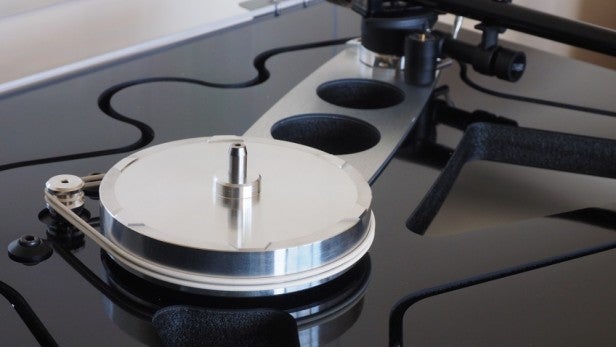
As with all Rega turntables, the RP8 is belt-driven, with two belts attached between the motor pulley and the machined aluminium sub-platter. The laminated platter is made from three pieces of glass, with the two lower pieces adding mass to the outer edge to increase the flywheel effect and keep everything spinning at a constant speed. It’s topped off by one of Rega’s familiar woollen mats.
The tonearm is the RB808 model introduced especially for the RP8. It’s unmistakably Rega in design, but offers a number of improvements over the lower-end models, such as hand-matched bearings and a new vertical bearing assembly. The low-capacitance cabling is all-new, too.
I’m a huge fan of the finger lift on Rega’s tonearms. It’s a generously sized hook that’s part of the same single casting as the headshell and tube, and it provides a perfect amount of control over the arm when you’re swinging it out over the record. Seems such a simple thing, but in the words of Carly Simon, nobody does it better.
Related: Rega Planar 3 2016 review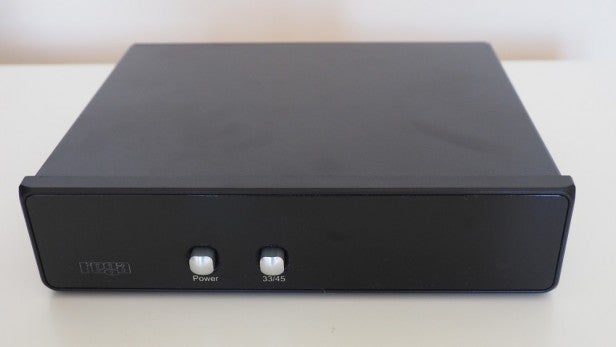
The RP8 is supplied with the Rega TT-PSU as standard, which is an external 24v power supply unit with controls for on/off and 33/45rpm speeds. It doesn’t exactly look offensive, although its red lighting is maybe a little 1980s, and how you feel about having the controls on a separate box might depend on how much shelf space you have.
Rega RP8 – Performance
Setting up the RP8 is a fairly simple process, especially if you’ve bought it with the Apheta 2 cartridge pre-fitted and aligned. You just need to place the glass platter on the spindle, level the plinth using the adjustable feet, wind the tonearm’s counterweight up to the correct tracking force, and set the anti-skate. Then the TT-PSU needs plugging into the socket on the rear.
If you’ve chosen to use the outer plinth, you can also slot the dust cover into the brackets at the back.
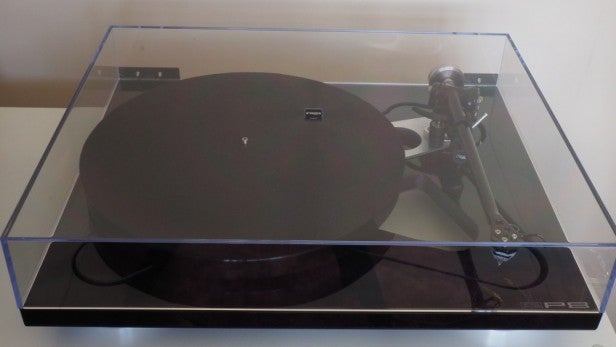
Since there’s no phono stage built in, I plugged the Rega RP8’s RCA cables straight into my Leema Acoustics Elements Ultra reference phono pre-amp, having set the correct cartridge loading for the Apheta 2.
As with all Rega turntables I’ve heard, the RP8 is wonderfully musical. Rega knows how to make vinyl sing. There’s plenty of snappiness to the treble, oodles of bounce to the bass, and an openness to the mid-range that helps put vocals to the fore.
And that’s not so say that it’s unsubtle. Spinning Sam Beam & Jesca Hoop’s beautiful Love Letter For Fire, the delicacy and intimacy of their gorgeous duets was never sullied. The RP8 added start-stop thump to the bass notes of “Sailor to Siren” without drawing attention away from the flawless harmonies. The bottom end is tight and controlled, albeit not exceptionally deep.
My only real criticism of the RP8/Apheta 2 combo is that the soundstage wasn’t always as expansive as I’d want at this price. It was more at ease with rock, folk and intimate acoustic recordings than with richly textured electronica and sweeping orchestral pieces.
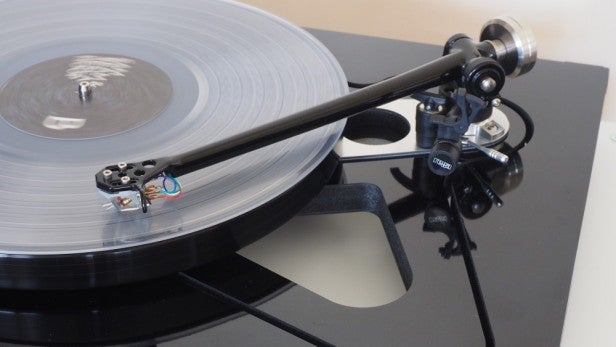
Should I buy the Rega RP8?
It may not have the grandstanding looks of some high-end record players, but the Rega RP8 is showy where it counts – it offers flair for the ears more than the eyes. The wonderful Apheta 2 cartridge seems to be a perfect match, and the saving when buying the two bundled together is well worthwhile.
If you fancy something a little more striking and with a tad more bass depth, the Pro-Ject 6 Perspex SB is a stunner and nearly £300 cheaper.
Related: T+A G 2000 R review
Verdict
A wonderful turntable that sounds a lot more special than it looks.


